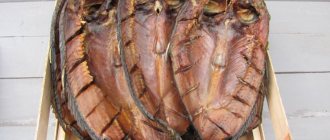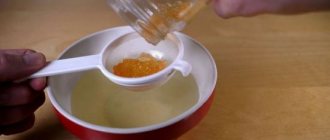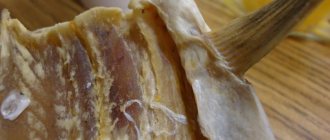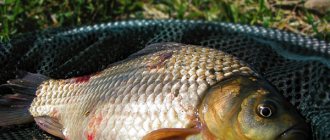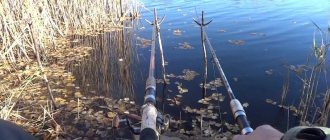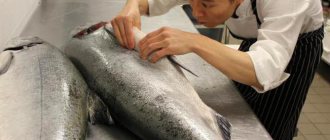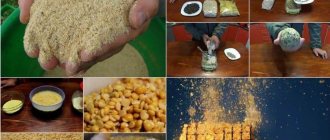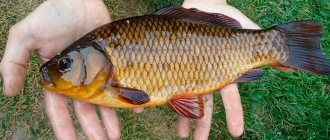The benefits of dried fish
Dried crucian carp meat is rich in proteins, vitamins and a number of minerals. Fish contains a sufficient amount of essential Omega-3 polyunsaturated fatty acids, which help the body bind and remove cholesterol, heavy metals, and toxins. This reduces the risk of malignant tumors, strengthens the cardiovascular system, increases immunity, strengthens the nervous system, and minimizes depressive conditions.
If you eat properly dried crucian carp, you can replenish calcium reserves by carefully eating small, fragile bones.
We would like to immediately reassure everyone who is watching their weight, because crucian carp is a low-fat fish. Therefore, such a low-calorie snack will not affect your figure in any way.
How to wither crucian carp
6 minutes Author: Konstantin Pavlov 0
- The benefits of dried fish
- Energy value
- How to dry fish correctly
- Preparing fish for salting
- Methods for salting crucian carp
- Preparing fish for drying
- Drying fish
- How to store dry milk
- Video on the topic
Dried crucian carp is considered a real delicacy; this snack is especially good with cool beer. At home, salting and drying this fatty fish is very simple. The main thing is to follow the correct sequence of actions and know some of the nuances of this process. Next, let's look at several recipes for dried crucian carp.
Preparing fish for salting
Before salting crucian carp, you need to prepare it properly. We thoroughly wash the fish under running water to remove as much mucus as possible. For large specimens, we rip open the belly, remove all the entrails, and thoroughly wash the inside. We leave small carcasses whole.
You need to salt crucian carp for drying carefully, paying special attention to the gills and mouth, because there are the most microorganisms that can cause spoilage of the finished product.
If there is a lot of fish, then the carcasses can be placed in layers in a suitable container or box, generously sprinkling the fish with salt.
If you come across caviar while cutting fish, there is no need to throw it away. You can salt crucian carp caviar using 0.5 tbsp per 100 g of product. l. salt and 0.75 tsp. table vinegar. First, we wash the caviar, mix it with salt and vinegar, and leave it in the refrigerator for 2-3 days. Then take it out and beat with a mixer with odorless vegetable oil (40 ml) until a light emulsion is obtained.
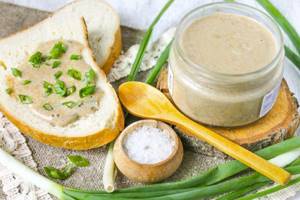
Crucian carp caviar makes very tasty snack sandwiches
Wet method of salting crucian carp
There is another way to salt crucian carp correctly and effectively. He is quite interesting and extravagant. Here crucian carp are salted using our own brine. That is, the fish itself will release the brine we need to form tasty and aromatic meat. Following this method, we take a deep container of enameled material so that it does not oxidize. Place the fish carcasses there, belly up. Sprinkle them with salt and sugar. Are you surprised? It’s not worth it - sugar gives the meat a more expressive taste, emphasizing its natural aroma and sweetness. In addition, with the help of sugar, the fish will become more tender. Next, press down the fish with pressure, as in the previous recipe. Leave for 7 days so that it is well salted. Only after 2 days will the brine we need begin to separate, so remain patient, gentlemen.
Now you know how to salt crucian carp for drying in several ways. Which method you choose is up to you. As for me, they are all equally effective and efficient. However, see for yourself.
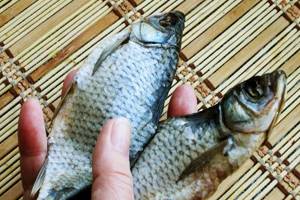
Methods for salting crucian carp
To figure out how to salt crucian carp for drying, let's talk about three main methods for properly salting fish before drying and drying.
Dry pickling
This is a very simple way to salt crucian carp at home.
- We take a wooden box and cover the bottom with a piece of canvas. The size of the box should correspond to the amount of fish being salted, but it is better to use a container with a wide bottom.
- We lay the prepared fish tightly in layers, head to tail. Sprinkle each layer generously with salt. For 10 kg of fish you will need 1.5 kg of table salt.
- When the layers of salted crucian carp are laid, we place a board with pressure on top. The load will remove excess air, which will slow down the development of harmful microorganisms.
- We leave the box for a week in a cool, dark place.
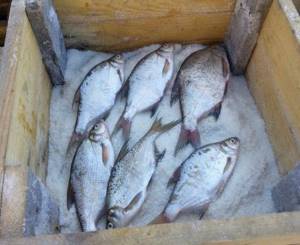
You need to put some kind of container under the box, because... already on the second day, fish juice will begin to flow out through the cracks in the bottom.
Wet salting
This method of salting in brine from fish juice is more popular because... makes the finished product very soft and elastic
- Salting is carried out in an enamel pan, into which the prepared fish is folded, belly up, in layers.
- Sprinkle each layer of crucian carp with a mixture of salt and sugar. For 10 kg of fish you will need 1 kg of salt and 1 tbsp. granulated sugar.
- Cover the container with the workpiece with a lid of smaller diameter than the pan. And place a weight on top (a jar of water works great).
- Place the structure in a cool, dark place for 7 days. After a couple of days, you will notice that the fish with salt will release juice, which will completely cover the crucian carp.
Wet salting in brine
According to this method, the fish, placed in an enamel container, is filled with strong brine.
How to dry pike
To prepare you will need:
- 3 kg of prepared crucian carp;
- 2 liters of water;
- 300 g kitchen salt;
- 1 tbsp. granulated sugar;
- 2 tsp granulated garlic;
- 3 tsp dry dill.
For more uniform salting, it is better to use carcasses of the same size.
The fish is placed tightly with its backs down, a salty solution is poured in, and oppression is established.
After a week in a cool place, the crucian carp are ready for further stages of preparation.
No matter how you salt the fish, after a week you can dry it. You can also salt fish for smoking using the same methods.
Preparing and salting fish
Salting crucian carp involves preliminary preparation of raw materials. Small and medium-sized specimens can be salted entirely without unnecessary cleaning. You just need to remove the mucus from the surface of the fish’s body, rub it with salt, and also sprinkle the gills and mouth thoroughly. In general, “fine fish” can be placed in layers in a basin or saucepan by simply sprinkling them with “white gold.”
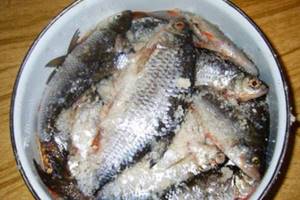
In the case of a large carcass weighing over 1 kg, a more responsible approach is required. Firstly, you need to gut the belly, and secondly, for faster drying, you should make a shallow cut along the entire length of the fish from the tail to the head along the ridge.
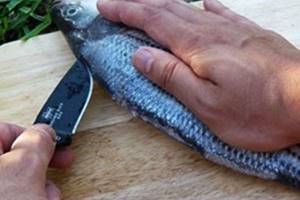
There is no need to remove the scales; on the contrary, their presence will protect the meat from salt combustion and drying out.
Having rinsed the fish, we proceed to salting the crucian carp. We thoroughly treat the body, abdominal cavity and head of the fish with salt, put it in a deep vessel, where it will rest for the next 5 days. However, this is not the only pickling option. The dry method is rightfully considered the highest priority.
Dry method
We take a wooden box and line its bottom with canvas, where we lay out the carcasses, placing them “head to tail.” We salt them generously (for 10 kg of fish we take 1.5 kg of salt). We place a wooden board or disk on top, and place a heavy load on it so that our crucian carp are under pressure, which will prevent the entry of air, which will have a most beneficial effect on the quality of the meat, and will also slow down the development of bacteria.
After a day or two, the fish will begin to release juice, which will find its way out through the cracks of the box. After a week, the raw materials will be thoroughly salted. All this time, our structure should be in a cool place.
Along with these types of processing, there is also a wet salting method, which also has its fans among culinary specialists.
Wet method
In order to properly and most importantly tastefully salt crucian carp for drying, you need to know exactly how to prepare the brine and how long to keep them in it.
For this simple procedure, we need a deep vessel, preferably enameled, or made of non-oxidizing metal. We put the prepared carcasses in it with their bellies up, cover them with salt with minimal addition of sugar at the rate of 1 kg of “white gold” + 1 tbsp. granulated sugar for every 10 kg of fish.

We need sweetness to add tenderness to the taste of the finished product. Then we press the crucian carp on top with a board with pressure and leave it cool. After 48 hours, the resulting salty solution will cover all the carcasses, which is what we wanted. Now you can wait a week and then start drying.
Preparing fish for drying
Before drying crucian carp, it must be prepared for this process. To do this, we take out the salted raw materials and thoroughly wash each carcass to remove mucus and excess salt.
After this, we place the fish in clean water for several hours, so that we can then begin the drying process.
Usually they soak for as many hours as the fish has been salted for days. If the salting lasted a week, then soak for exactly 7 hours.
Drain off the excess water and place the fish in a colander, straining out the excess liquid. Then dry each carcass thoroughly with a towel or napkin. To protect against annoying insects, we treat each carcass with a weak vinegar solution or vegetable oil.
How to cook “Marinated crucian carp”
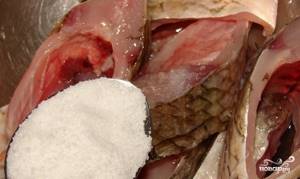
We clean the crucian carp from scales, gut it, rinse thoroughly under cold water and cut into pieces 2 centimeters wide. Add salt and mix.
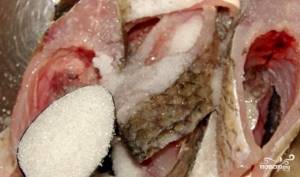
Then pour vinegar over the fish and add sugar and mix again.
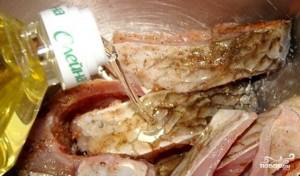
Add vegetable oil and mix again.

Peel and cut the onion into rings and place in a bowl with the fish.
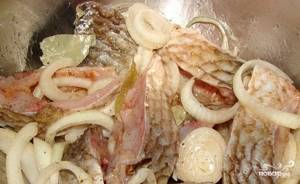
Add all the spices listed in the composition and mix thoroughly.
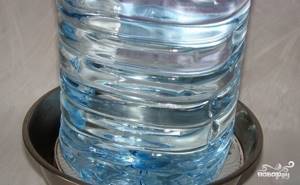
Let the fish marinate under pressure for at least a day. It is necessary to stir it several times during the day and return it under pressure again.
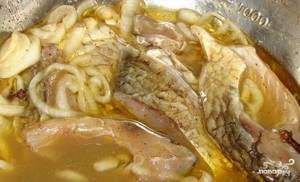
After a day, you can take a sample. If you are going to cook pickled crucian carp for future use, then put the remaining pieces in a glass jar, fill with brine and put in the refrigerator.
Drying fish
To dry fish, we put the carcasses on a fishing line or twine, making holes in the lip, eye or tail. You can also put each carcass on a separate hook, then it is convenient to remove and fold it.
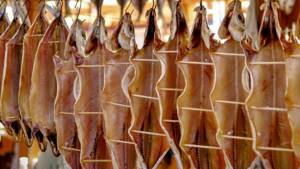
To speed up the drying process, toothpicks are inserted into the bellies.
It is very important to choose the right place for drying. It should be windy and well warmed by the sun. If it is not possible to dry fish outside, then you need to choose a spacious room with drafts.

Drying fish outdoors
A separate problem is flies and other insects. Sitting on carcasses, they lay eggs, from which worms hatch over time. Unfortunately, such a product will be hopelessly damaged.
To avoid contact with insects, the dried product is wrapped in gauze, placed in special multi-tiered dryers, or wiped with vegetable oil and vinegar.
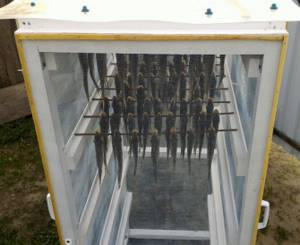
Craftsmen themselves make drying boxes, covering them with mosquito nets or gauze.
Under favorable weather conditions, we dry the fish for 3 days to 2 weeks.
- Dried fish is dried for 5-7 days;
- It will take 1-2 weeks to make a battering ram.
We check the readiness of the fish by pressing on the back: it should be elastic and dense.
Dry method of drying crucian carp
Compound:
- crucian carp – 3 kg;
- salt – 0.45 kg.
Cooking method:
- Lay a canvas cloth on the bottom of a wooden box and sprinkle it generously with salt.
- Gut, rinse and dry the crucian carp with a kitchen towel.
- Place the first layer of crucian carp tightly. For it, choose the largest fish. You need to lay crucian carp in “soldiers” (that is, heads to tails), then they will lie more densely.
- Sprinkle the crucian carp with salt and place a second layer of fish. Sprinkle with salt. So gradually fill the box with fish so that the smallest carp are on top. Sprinkle with remaining salt. It is important to make sure that it is also at the sides of the box, and not just on top of the fish.
- Cover the fish with a board slightly smaller than the size of the box. Place a weight on top.
- Leave the box in a cool place for a week.
- Fill a basin or bucket with cool water. Shake off the remaining salt from the crucian carp and immerse them in water. Leave for 7 hours.
- Dry the soaked crucian carp with a towel. Place spacers in the bellies so that the fish is dried not only from the inside, but also from the outside. Thread the crucian carp onto a fishing line, cover with gauze, and sew its edges.
- Hang the line with the fish in a well-ventilated place and leave for 5-7 days.
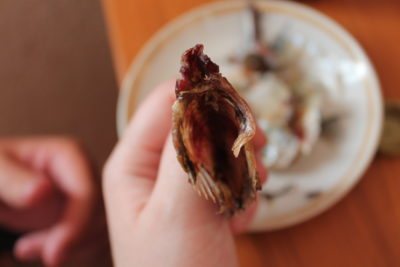
All that remains is to remove the fish from the line and put it in a dry storage box. You can eat it immediately, or you can wait for a suitable occasion for two weeks.

